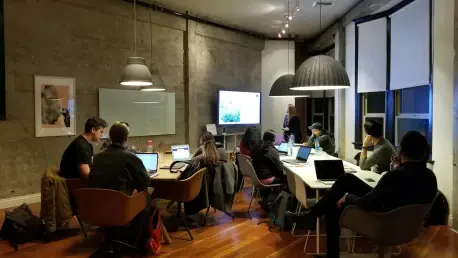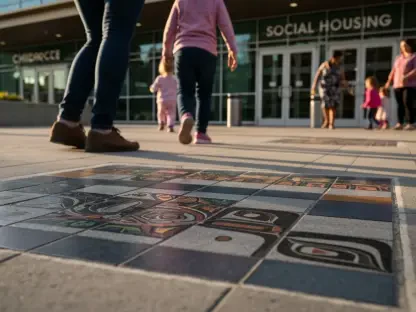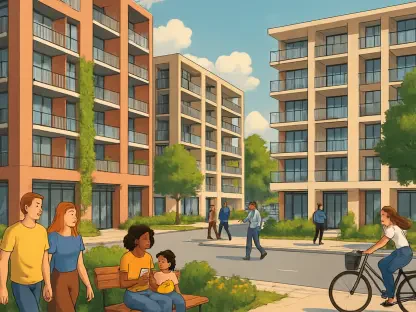In an ever-evolving landscape, workplace design plays a vital role in shaping how we work and interact. Luca Calarailli, an expert in construction and architecture, brings his insights into various transformative trends in workplace design, including flexibility, technology, inclusivity, and sustainability. With a keen eye on the integration of technology and innovative strategies, Luca explores how design can adapt to changing work environments and preferences, ensuring that offices remain conducive to productivity, collaboration, and employee wellbeing.
What are the key reasons companies are focusing more on creating flexible office environments?
Companies are increasingly acknowledging that the traditional one-size-fits-all approach no longer meets the diverse needs of today’s workforce. With many employees choosing to perform focused tasks from home, they seek office environments that foster collaboration and connection. Flexibility in design allows spaces to evolve to suit varying needs and preferences, enabling companies to maximize utility and satisfaction among their employees.
How do you think the shift towards more collaboration spaces over individual workstations will affect employee productivity and engagement?
Transitioning to collaboration-centric designs can significantly enhance productivity and engagement by providing employees with environments that encourage connection and creativity. When workers have spaces that facilitate teamwork, spontaneous interactions, and dynamic exchanges, it nurtures innovation and problem-solving, vital components of any successful workplace.
Can you explain how furniture plays an important role in achieving flexibility in office design?
Furniture contributes significantly to the flexibility of office spaces. Unlike traditional constructions, furniture can be easily reconfigured to create different setups, allowing employees to customize their work environment. This adaptability encourages a sense of ownership among users and supports different work styles and tasks, from individual focus to group collaboration.
In what ways are companies incorporating technology to transform traditional workspaces?
Organizations are integrating technology to create dynamic work environments. Technologies like AI-enabled systems streamline various office functions, from locating colleagues to optimizing meeting arrangements. By embedding these tools into workplace design, offices can become more efficient and responsive to the needs of employees, ultimately transforming how work is done.
How can AI contribute to enhancing physical comfort in the workplace?
AI has the capacity to enhance physical comfort by learning and adapting to user preferences, such as lighting, temperature, and desk arrangements. By automatically adjusting these settings based on individual patterns, AI helps create comfortable and personalized environments that enable employees to focus completely on their tasks without the distraction of adjusting their surroundings.
Could you give examples of how AI is being used to streamline day-to-day tasks in the office?
AI is streamlining office routines by taking over repetitive tasks, such as drafting meeting notes, organizing schedules, and managing digital documents. By automating these processes, AI frees up time for employees to concentrate on more strategic and creative endeavors, enhancing overall productivity and workplace efficiency.
How has the pandemic influenced employee preferences for workplace experience, and what role does office design play in that?
The pandemic has shifted employee expectations towards experiences that provide a balance between professional collaboration and personal wellbeing. Employees value environments that offer social interaction opportunities and amenities that enable them to manage stress. Office design plays a critical role by creating spaces that are not only functional but also enhance a sense of belonging and support mental wellbeing.
What strategies can organizations implement to create spaces or amenities that promote balance and wellbeing for employees?
Organizations can implement diverse strategies like providing quiet zones for reflection, wellness rooms, or outdoor areas to encourage relaxation and mental rejuvenation. Incorporating amenities like gyms or meditation rooms also demonstrates a commitment to employee health, fostering a balance between work and personal life, and motivating employees to return to the office.
Why is hybrid work considered a permanent change in workplace dynamics, and how are companies adapting their designs to accommodate this?
Hybrid work is now a mainstay due to its ability to combine the benefits of remote work with in-office collaboration. Companies are adapting by designing spaces that support seamless transitions between home and office settings, using technology to bridge the gap between remote and on-site workers, ensuring interconnectivity and inclusivity in team interactions.
How can technology, such as AI cameras and advanced conference tables, support inclusivity in hybrid work environments?
Advanced technologies, like AI cameras and smart conference tables, create equitable collaboration environments by making remote participants feel just as involved as those physically present. These tools capture and share visual content effortlessly, ensuring that all team members, regardless of location, have equal access to information and opportunities for contribution.
What design considerations should companies keep in mind to support neurodiverse employees in the workplace?
Companies should consider a variety of spaces that accommodate diverse sensory needs, offering both low-stimulation areas and controlled sensory environments. Incorporating sound management solutions, clear signage, and wayfinding aids can help navigate spaces effectively while providing comfort and safety for neurodiverse employees, ensuring an inclusive and supportive work environment.
In what ways can office design balance high-tech environments with low stimulation areas?
Balancing technology-driven design with low stimulation areas involves creating distinct zones that cater to different activities. High-tech areas can foster energy and interaction, while carefully designed low stimulation zones provide respite and concentration. This balance allows employees to choose environments that align with their tasks and sensory preferences.
Why is sustainability in the workplace non-negotiable, and how do ESG policies impact employee decisions?
Sustainability is a core principle because it aligns with broader societal expectations for environmentally responsible practices. ESG policies influence job seekers who increasingly prefer to associate with companies committed to sustainability. Promoting eco-friendly practices can set companies apart, affecting recruitment and retention positively.
How do sustainable design elements go beyond just material specifications, and what aspects are now considered crucial?
Sustainable design encompasses not just materials but also elements like indoor air quality, water management, and access to green spaces. These factors impact the overall health and wellbeing of employees, making them essential components of a broader commitment to sustainability that protects the environment while supporting employee satisfaction and retention.
Why are rating systems like WELL and Fitwell gaining popularity over traditional certifications like LEED in workplace design?
WELL and Fitwell are gaining traction because they focus on comprehensive wellbeing factors beyond traditional building certification. These systems evaluate aspects like mental health support, physical activity facilities, and social engagement opportunities that contribute to overall employee health and satisfaction, offering a more holistic approach to sustainable office environments.
What steps should designers take to ensure they are pushing boundaries and maintaining creativity in evolving office design trends?
To continually innovate in office design, designers should embrace new technologies, encourage interdisciplinary collaboration, and engage with diverse ideas. Continuous learning and experimentation with materials, layouts, and technologies will help designers remain at the cutting edge, delivering creative solutions that meet the evolving demands of modern workplaces.
Do you have any advice for our readers?
My advice would be to remain open to change and embrace new technologies and design concepts. Staying informed about trends and listening to employee feedback can foster environments that meet current and future needs, ensuring workplaces remain vibrant and adaptive spaces that inspire creativity and productivity.









